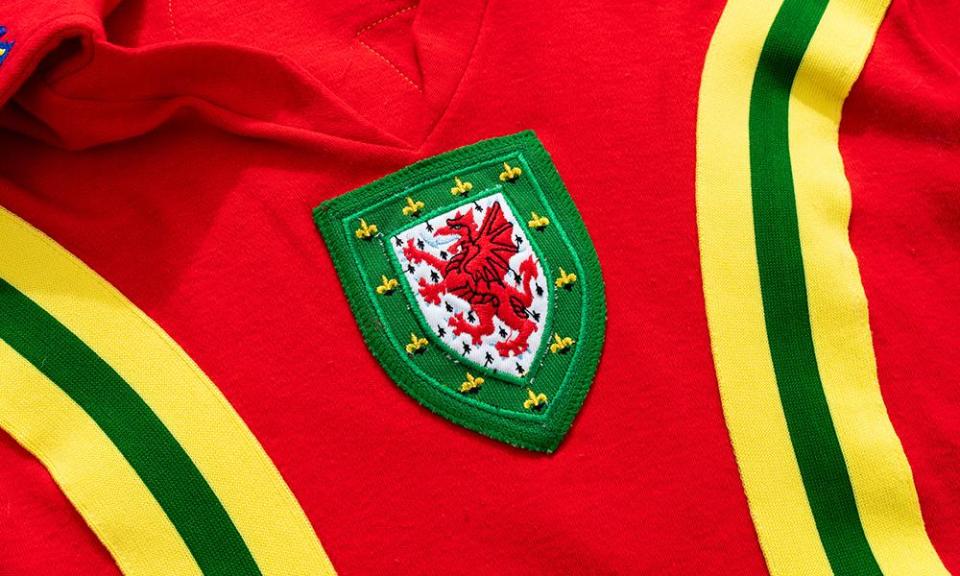Yellow, red, green and glorious: Remembering Wales’ Admiral ‘76 kit

It’s probably not controversial to suggest that almost every fanbase, if pushed, would identify their side’s greatest ever shirt as arriving somewhere between the mid-70s, when things started to get interesting, and the late 90s, when things started to get out of hand. And it’s pretty much a given that for any Wales fan, unless they’re particularly attached to Billy Meredith’s lace-up collars, it’ll be Admiral ‘76.
The boys of ‘58 are the best of Wales, for they had the best players and they had the best story. John Charles, the greatest player in the world, injured for the quarter-final. Pelé, 17, about to take the first step on the journey to becoming Pelé. A case can be made that Wales would have won that game with a fit Charles up front, and as such a case can be made that Wales would have won the World Cup, Pelé notwithstanding. It is not, if we’re being honest, an open and shut case.
Then there’s Gareth Bale and company, who made it to three major tournaments out of four. Much of the praise they received ahead of Euro 2016 was connected to 1958: these were the drought breakers, bringing the sweet wet kiss of major tournament football back to a parched and thirsty land. Twice, by some bizarre twitch of fortune, Wales’ men’s team had found themselves in possession of one of the best players in the world. Twice he’d had a pretty decent supporting cast. Twice that had made the difference between there and not there.
As for the boys of ‘76, they did not make it to the finals of the Euros. Still, they remain the only Wales team ever to top a qualifying group. Bale and co got to the Euros twice as runners-up, and needed the playoffs to make Qatar 2022, while the path to 1958 was a meandering thing that involved getting knocked out of the European zone, then getting thrown into a playoff against Israel, who had advanced through their qualifiers without playing a game, as opponent after opponent withdrew against the backdrop of the Suez crisis and the Arab League boycott. Technically, Wales went to Sweden as the representatives of Asia and Africa.
It is one of the quieter iniquities of football: the finest kits don’t always clothe the finest football, and the worst don’t always get lumbered with the worst. But while great kits may not always get the performances they deserve, they do acquire resonance in other ways. They gather up stories. Particularly back then, back in the day, when kits were allowed to hang around for season after season, and so came to be associated not just with one campaign but with generational cycles, with teams as they shifted and fans as they grew. This is the Wales kit of that George Berry photo. And this is the Wales kit of perhaps the greatest of the celebrity-in-kit stories. Keep your Drake. The rumour, the myth, the legend has it that Bob Marley wore the Admiral ‘76 tracksuit top on television.
Nobody seems to be able to find the actual clip, but that’s a modest inconvenience. Kit myths evade the scientific method and speak straight to the heart. Marley wore a (navy blue) tracksuit when he was playing in Battersea Park; Admiral head honcho Bert Patrick once claimed that reggae fans were buying the Wales range because it was red, green and yellow … you can see how and why it “happened”, even if it never actually happened. And in any case, the absence of photographic evidence doesn’t matter.
But what about on the pitch? The Admiral kit failed to qualify for the 1978 World Cup in Argentina: Wales finished bottom of Group 7 after the suits made the dreadful decision to play their last home qualifier, a must-win game against Scotland, at Anfield. The Scottish fans poured down in their thousands, Joe Jordan handled the ball and got a penalty for it, misery and woe abounded. They missed out on an expanded eight-team Euro 1980 after a 2-0 defeat to West Germany – George Berry’s debut.
And then there was ‘76. Call it another failure on technical grounds, or call it an overlooked and underappreciated success, the general consensus seems to be that Yugoslavia were the better team over two legs, and deserved to progress to the finals in … huh, Yugoslavia. Terry Yorath later blamed himself for missing a penalty in the second leg in Cardiff, a 1-1 draw, but most of the rest of the country blamed the referee. Nobody enjoyed the penalty he gave Yugoslavia, nor the Wales goals he ruled out. Indeed, the crowd liked it so little that Wales ended up banned from playing in their own capital.
But look up the footage now and it’s the kits that really pop out. Yugoslavia are wearing a strong, sensible blue, with three stripes running down long sleeves. They look precisely as they should. Wales, though. Big lapels. Tight shirts. Short sleeves. Those yellow streaks arcing up from the legs and flashing outwards, accentuating the shoulders, making the big hair bigger. The winning team are anchored firmly in the present; the losing team are losing, yes, but they are bringing through a delirious and uncertain future.
This Admiral kit contains all that is to come in kit design, for good and for ill: it will unfold into every triumph and every failure, every misstep, every hubristic adventure into colours that aren’t real and shapes that shouldn’t be. Squint and you can see the eighties forming, pulsing, ominous. Squint harder and you can see the nineties, in all its psychedelic terror. Squint even harder and you’ll pass out, yellow and red and green dancing behind your twitching eyes.
This is an edited extract from “Admiral: 50 years of the Replica Shirt”. A limited edition is available to pre-order now.

 Yahoo Sport
Yahoo Sport 



































































